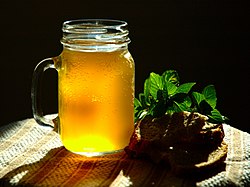
Back Kwas (drank) Afrikaans كفاس Arabic كفاس ARZ Kvas Azerbaijani Gėra BAT-SMG Квас Byelorussian Квас BE-X-OLD Квас (напитка) Bulgarian Kvas BS Kvass Catalan
 A mug of mint kvass and its ingredients | |||||||
| Alternative names | kvas, quass, quasse, quas, quash, kuass, kwas, gira | ||||||
|---|---|---|---|---|---|---|---|
| Type | Fermented low-alcoholic beverage | ||||||
| Course | Beverage | ||||||
| Region or state | Northeastern Europe; Central and Eastern Europe; North Caucasus; Xinjiang, China; Heilongjiang, China | ||||||
| Associated cuisine | Slavic (Belarusian, Polish,[1] Russian,[2][3][4] and Ukrainian), Estonian, Latvian, Lithuanian and Uyghur cuisine | ||||||
| Serving temperature | Cold or room temperature | ||||||
| Main ingredients | Rye bread or rye flour and rye malt, as well as water and yeast | ||||||
| Ingredients generally used | Berries, fruits, herbs, honey | ||||||
| Variations | Beetroot kvass,[5] white kvass[6] | ||||||
| Circa 30–100 kcal | |||||||
| |||||||
Kvass is a fermented, cereal-based, low-alcoholic beverage of cloudy appearance and sweet-sour taste.
Kvass originates from northeastern Europe, where grain production was considered insufficient for beer to become a daily drink. The first written mention of kvass is found in Primary Chronicle, describing the celebration of Vladimir the Great's[8][9] baptism in 988.[10] In the traditional method, kvass is made from a mash obtained from rye bread or rye flour and malt soaked in hot water, fermented for about 12 hours with the help of sugar and bread yeast or baker's yeast at room temperature. In industrial methods, kvass is produced from wort concentrate combined with various grain mixtures. It is a popular drink in Poland,[11][12] Russia,[13][3] Ukraine, Belarus, Lithuania, Latvia, Estonia, Moldova, as well as some parts of Finland, Sweden, Uzbekistan, Kazakhstan, and China.
- ^ "Co warto wiedzieć o kwasie chlebowym" (in Polish). WP Kuchnia. 8 January 2016. Archived from the original on 22 October 2023. Retrieved 28 November 2023.
- ^ "Kvas Patriotism in Russia: Cultural Problems, Cultural Myths". NYU Jordan Center. Archived from the original on 2 March 2022. Retrieved 28 November 2023.
- ^ a b "A brief history of Kvass, Russia's 'bread in a bottle'". Russia Beyond. 23 August 2021. Archived from the original on 30 November 2023. Retrieved 28 November 2023.
- ^ "История кваса и его полезные свойства" (in Russian). Сергиев Канон. Archived from the original on 30 November 2023. Retrieved 28 November 2023.
- ^ Amaresan, Natarajan; Ayyadurai, Sankaranarayanan; Dhanasekaran, Dharumadurai, eds. (2020). Fermented Food Products. Taylor & Francis. pp. 287–292. ISBN 978-0-367-22422-6.
- ^ Tarasevich, Grigory (5 September 2013). "White kvass: An old drink with a new taste". Russia Beyond. Archived from the original on 20 July 2021. Retrieved 30 July 2021.
- ^ a b c Līdums, Ivo; Kārkliņa, Daina; Ķirse, Asnate; Šabovics, Mārtiņš (April 2017). "Nutritional value, vitamins, sugars and aroma volatiles in naturally fermented and dry kvass" (PDF). Foodbalt. Faculty of Food Technology, Latvia University of Life Sciences and Technologies: 61–65. doi:10.22616/foodbalt.2017.027. ISSN 2501-0190. Archived (PDF) from the original on 4 January 2022. Retrieved 4 January 2022.
- ^ "Vladimir the Great: From Pagan Philanderer to Christian Saint". Dance's Historical Miscellany. 8 April 2014. Archived from the original on 30 November 2023. Retrieved 28 November 2023.
- ^ "Vladimir Adopts Christianity". Christian History Institute. Archived from the original on 5 December 2023. Retrieved 28 November 2023.
- ^ "Павел Сюткин: Квас без прикрас – правда и мифы о традиционном русском напитке" (in Russian). Российский Союз Потребителей (Росконтроль). Archived from the original on 30 November 2023. Retrieved 28 November 2023.
- ^ "Co warto wiedzieć o kwasie chlebowym" (in Polish). WP Kuchnia. 8 January 2016. Archived from the original on 22 October 2023. Retrieved 28 November 2023.
- ^ "Kwas chlebowy i jego znaczenie dla zdrowia. Przepis na kwas chlebowy" (in Polish). Medonet. 19 December 2022. Archived from the original on 30 November 2023. Retrieved 28 November 2023.
- ^ "История кваса и его полезные свойства" (in Russian). Сергиев Канон. Archived from the original on 30 November 2023. Retrieved 28 November 2023.